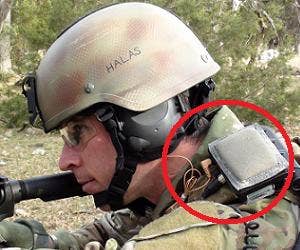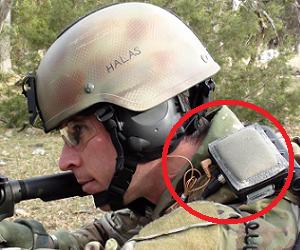US Soldiers Using Sniper Detecting Microphones (video)

Share
Small lightweight microphones are saving the lives of US soldiers fighting in Afghanistan and Iraq. Shoulder Worn Acoustic Targeting Systems (SWATS), developed by defense company QinetiQ, use shockwave and muzzle blast noise to locate enemy gunfire . A single shot is all it takes to give the soldier the bearing and distance to the sniper trying to take his life. A tactical display or audio alert from the device tells the soldier where to look so they can return fire or take cover. With SWATS, you go from sitting duck to well-informed angry defender in less than a second. QinetiQ recently announced that the US Army had ordered 13,500 SWATS units, with the option to pick up 30,000 more. The Marine Corps placed an order for 900. According to the MC Times, these branches already have roughly 4000 and 150 of the units in the field, respectively. Watch SWATS in action with real gunfire in the videos below. Sensors like these are just some of the many devices that are augmenting human soldiers for modern warfare.
In urban environments, echoes and architecture and conspire to hide the location of enemy gunfire. Human ears, even well trained ones, can get confused trying to pick out where a shot is coming from. In open fields, bearing is easier to judge, but distance is still difficult. Devices like SWATS help with both scenarios. In urban settings they can pinpoint snipers even in complex acoustic environments out to several hundred meters, and in open fields they have an even greater range. Best of all they provide visual and/or audio feedback less than one second after detection of gunfire, and weigh less than a pound so anyone can wear them. At $5000 each, they aren't exactly cheap, but they're not prohibitively expensive either. Considering the orders placed by the Army and Marine Corps we could expect many more of them to be in the field in the next few years. You can skip to 1:00 in the following clip to see the live fire demonstration for SWATS:
SWATS is just one device in a larger suite of tactical microphones from QinetiQ. The Ears gunshot localization systems include vehicle mounted versions as well. These are only slightly heavier and more energy demanding than their shoulder worn counterparts, but have more sophisticated displays and can track gunfire even when the vehicle is moving at speeds up to 80 km/hr (~50mph). Here's a great demonstration of the vehicle Ears gunshot localization system:
Be Part of the Future
Sign up to receive top stories about groundbreaking technologies and visionary thinkers from SingularityHub.


I should point out that the US military has been developing acoustic sensors like SWATS for many years. The Boomerang system from Raytheon has been in the field since 2005 and has won awards for its use. SWATS is simply smaller, lighter, and cheaper than many competing devices. It's unclear if the vehicle mounted varieties of QinetiQ's Ears present similar advantages over previous models. Actually, it doesn't matter if they do. In general there are enough different companies working on these types of sensors that we're likely to see further improvements in acoustic targeting in the years ahead.
In fact, we're likely to see many more such augmenting technologies. Acoustics are just the low hanging fruit. There are laser systems which could detect reflections off sniper scopes to pinpoint enemy shooters more precisely. IR/thermal scanning devices are also available. All sensors could be tied in to heads up displays to give augmented reality targeting assistance to soldiers. As we've discussed before, the human soldier of the future could be fitted with many such devices to turn them into super sensing, super accurate fighters.
Eventually, however, I think all of these sensors are just a step towards creating an artificial soldier. SWATS can tell a human where an incoming shot is coming from in less than a second, but it may take many more seconds for the human soldier to find its target and return fire. Machines can detect and retaliate much quicker. We've already seen automated turrets for anti-personnel and anti-missile purposes - this kind of technology is (mostly) already here. Make them mobile, let them be driven remotely the same way we pilot armed drones, and there are many operations that would no longer require human soldiers. That future is still years away, but I think that's where all this human-enhancing tech is ultimately headed.
Until the advanced militaries of the world reduce their use of human soldiers, it's still part of their job to preserve as many of their soldier's lives as possible. To that end, the SWATS (and Ears) devices are a godsend to the US. Asymmetric warfare favors the forces that can strike and runaway unharmed. With plentiful acoustic sensors in the field it will be that much harder for snipers to ambush soldiers and live to escape. As thousands of these devices flow into Afghanistan it looks like the US will have yet another decisive technological advantage. Let's hope it helps end the war that much more quickly.
[image credit: QinetiQ via Marine Corps Times]
[video credits: QinetiQ North America TSG, QinetiQ Group]
[sources: QinetiQ, Marine Corps Times]
Related Articles

This Portable Wind Turbine Is the Size of a Water Bottle and Charges Devices in Under an Hour

Mojo Vision’s New Contact Lens Brings Seamless Augmented Reality a Step Closer
The Weird, the Wacky, the Just Plain Cool: Best of CES 2020
What we’re reading
